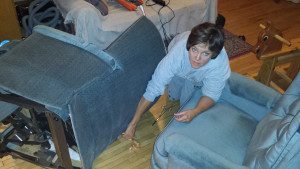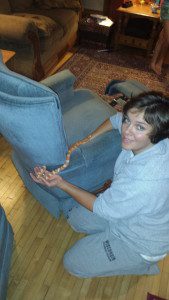Whenever I manage to sneak my family and myself away from our regular life for a week during the winter, I feel I owe it to my clients, my children's teachers and myself to broaden my horizons in an educational way while soaking up some sun. I recently returned to frigid Wisconsin after visiting family near Cocoa Beach, Florida, enriched with vitamin D and the following unusual animal encounters.
We kicked off our trip by driving through the
Merritt Island National Wildlife Refuge for a nominal park fee of $5.00. If you are a bird watcher, this is a must-do while on the Space Coast of Florida. Upon entering you receive a check list of migratory and resident birds that you might observe in the sanctuary. Although I'm no birder, I enjoyed identifying coots, pelicans, ibis, herons, egrets, osprey and grebes and simply appreciated the sheer number and beauty of scores of unidentified birds. We also drove past several Florida soft-shelled turtles, a few non-venomous water snakes and some alligators.
The most memorable alligator experience of our trip occurred on this outing when we drove past a
 |
| Dr. Kim Everson investigates a road-killed alligator |
particularly large alligator lying strangely close to the highway on our way into the Refuge. When we observed the gator unmoved from this location on our exit, we paused to investigate. Having now witnessed numerous cold, sluggish alligators in Florida winter, I assure you a sleepy alligator basking in the sun and a dead road-kill alligator look remarkably similar. Neither may blink or appear to be breathing. Even blood on the roadway is no guarantee you've encountered a dead reptile rather than a recently feeding one! With an abundance of caution I approached the alligator, saddened but also relieved to find its skull had been crushed by an automobile and it was utterly dead.
Florida alligators are a huge tourist attraction in Florida inspiring both awe and fear. After being added to the Endangered Species list in the 1960s, the American alligator has been successfully restored to healthy numbers. And as fearsome as these giant "lizards" are (by the way, alligator is derived from the Spanish word for lizard "el lagarto"), it really is possible to co-exist peacefully with them. Since 1948, when records started being kept, only twenty people have been killed by alligators in Florida. What's more, alligators are being studied for clues into their remarkable capability to heal and fight off infections -- they may even help unlock a
cure for AIDs.
 |
Rhiannon shares The Dinosaur Store's gentle tegu,
a South American omnivorous lizard with Dr. Kim Everson |
It was a close-up view of alligators that lured us into Cocoa Beach's
The Dinosaur Store on a particularly chilly day, but what kept us there were reptiles of a different stripe and a friendly herpetologist, Rhiannon Bonine. I peppered her with questions about reptile genetics, husbandry and how to treat common ailments. Rhiannon and I chatted about the difference between albino and leucistic (aka color dilute) animals, the causes and treatment for stomatitis in snakes (sometimes these mouth infections occur after the snake is bitten by its rodent prey), and the difference in porosity between crocodiles and alligator skeletons (the small holes lighten their skeletal weight and aid their keen ability to sense swimming prey). The tail end of our energetic conversation turned to conservation issues ranging from efforts to protect endangered Florida panthers and Chinese alligators to efforts to eradicate invasive pythons and toads. The Dinosaur Store keeps a gigantic fat Bufo toad, which they've decided is female due to her remarkable girth (she looks to be about the size of a canned ham) and notable silence.
 |
Dr. Kim Everson poses with a Bufo marinus toad, a
Florida invasive species and a poisonous pest to pets |
Seeing live Bufo toads up close and personal at The Dinosaur Store and the
Brevard Zoo was a real surprise and a treat. In veterinary school, our toxicology professor harped on the importance of understanding Bufo toad poisonings in pet dogs. Fortunately venomous Bufo toads are not found in Wisconsin -- our local toads just taste very yucky! The Bufo toad (
Bufo marinus) is an
invasive species in Florida, having been accidentally released near Miami in the 1950s after being used elsewhere to control grubs damaging sugar cane fields. Unfortunately, a Bufo toad loves to eat everything including native Floridian frogs and toads. Additionally, the milky toxin it secretes from the parotoid glands at the back of its head can kill dogs and cats that accidentally ingest the secretion!
 |
| Approaching an armadillo |
Another topic in veterinary school that seems very exotic and unhelpful until you watch your son chasing it across a ditch is a leprosy-infested armadillo. Until this recent vacation, the only armadillos I'd ever seen were as are dead as raccoon on the Florida roadside. On this trip I watched my fearless eldest child stalk an armadillo, peacefully nibbling grass, near Kennedy Space Center. Besides being shocked to learn that armadillos hop like armored bunnies when slowly approached (in fact, the Aztecs called them "turtle-rabbits"), my family learned that armadillos can carry the dreaded bacteria which causes leprosy. Although now relatively rare and readily treatable,
leprosy is a disease of biblical proportions that makes me loathe to get too close to a potential carrier.
 |
At Clearwater Marine Aquarium, Dr. Kim Everson observes
physical therapy --tail stretching exercises--performed
on Winter |
One thing I've learned on my visits to Florida is that wildlife abounds, many times where you don't want it to. An entire industry exists to serve as ambassador between unwanted or injured animals and the public. For example, herpetologist Rhiannon Bonine described the work of
Roaming Reptiles, an educational company which responds to emergency calls from concerned citizens with snakes in their homes that need to be carefully captured and relocated. Some of these snakes are venomous, but many are not. The beauty of such a service is that innocent but wayward reptiles are valued and preserved in the ecosystem. Another now-famous animal rescue and rehabilitation organization is
Clearwater Marine Aquarium. During a 2012 visit, I was given an incredible
behind-the-scenes tour of the facility that continues to rehabilitate "Winter," dolphin star of the two "Dolphin Tale" movies. While the goal of Clearwater Marine Aquarium (CMA) is to rescue stranded or injured marine animals, rehabilitate them through nutritional, medical and surgical care, and release them to their natural habitat, the CMA has on occasion taken in animals who will not survive back in the wild. Winter, the tail-less dolphin, is the most famous example, but my kids and I enjoyed meeting other permanent residents of CMA which include an otter named Cooper who was discovered in a Florida garage with partial hind limb paralysis (he can swim like nobody's business) and Harold, one of two blind sea turtles whose visual impairment is being aggressively studied for clues that may help understand vision-loss in wild turtles.
 |
Dr. Kim Everson admires a sponge
washed up on a Clearwater beach |
The last and least likely animal I learned about on my winter vacation is the sponge. Yup. Sponge. Like the sponge with which you wash your car. Sponges are multicellular invertebrate marine animals which do not have digestive, circulatory or nervous systems. Anyone who has seen a sponge will agree they consist of pores and channels through which water is channeled to exchange nutrients and waste products. As I walked along Clearwater Beach I examined a variety of washed-up sponges--finger sponge, stovepipe sponge, giant yellow sponge... Meeting one of the most primitive animals ever is pretty cool, but after visiting the
Sponge Docks in Tarpon Springs, Florida, I have an even greater appreciation. The use of sponges in daily life is documented back thousands of years but the harvesting of sponges has changed very little in all that time. Earliest sponge harvesting was accomplished by wading and swimming offshore to collect specimens. As this easy-to-reach population was depleted, sponge hunters became divers, peering at the seabed through glass bottom buckets from little boats then diving great depths to collect their harvest. Hardhat diving apparatus (those alien-looking round copper helmets right out of
Creature from the Black Lagoon) revolutionized sponge collection allowing sponge divers to remain on the seabed for significantly longer periods of time. SCUBA has mostly replaced other forms of diving, but once the sponge is on the boat processing remains the same as it has been for centuries! The sponge fishermen process their catch by rinsing and pressing the sponges repeatedly to remove seawater and slimy sponge goo, then they string them by type and size on long "needles" which hang all along the ship to dry. Back at the sponge docks, the sponge are sorted, trimmed and sold in batches at auction. Different species of sponge are valued for different cosmetic, household and decorative uses. Although sponge is a renewable resource, sponge fishermen must adhere to strict rules about the size of sponge that can be harvested and how to collect sponge without destroying the animal's ability to regenerate.
Vacations are how we humans regenerate, er...re-energize? And the best vacations, in my opinion, are those during which you learn something new. On my recent winter vacation I enjoyed seeing the Florida world -- sponges and snakes, alligators and armadillos, toads and tegus -- through my inner child's wondering eyes as well as my veterinarian's analytic ones.
In loving memory of my uncle Ed Hansen, who loved his farm animals,
but also took time to travel the world with his beloved family.















